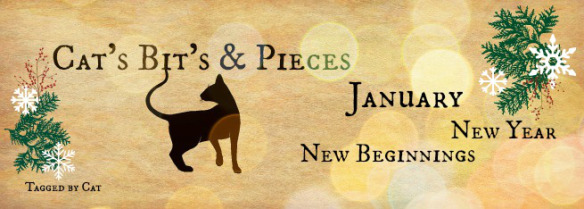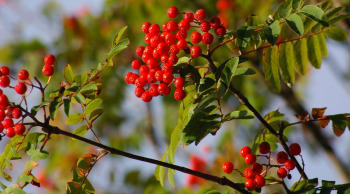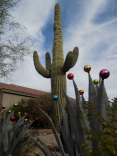 Celtic Month of Rowan January 21 – February 17
Celtic Month of Rowan January 21 – February 17
TREE INFORMATION
The Rowan tree is also known as the Mountain Ash and are members of the rose family. They can be found growing among ancient settlements and ruins in Europe where they grow “like weeds”, although many of these trees were planted there as well. Rowans can grow almost anywhere and do well in poor soil, which would explain their growth in many areas. It grows well in high altitude and can grow up to 40 ft in height and produces flowers in May, after which come the red berries. The berries are said to be sacred food of the gods which were jealously guarded and kept away from man. The tree itself has a round , open top crown and the leaves which turn red in the fall are 4-8 inches in length and oblong with serrated edges along the point. The berries grow in clusters and each berry has a small design that resembles a pentagram on it. It was this pentagram “design” that linked this tree to witchcraft during the 15th and 16th centuries, it’s reputation became so negative that herbalist’s stopped using it for fear of being labeled as a witch.
The bark from the Rowan tree is used for tanning and making dye and the berries are edible and make great jams and jellies. The berries are also still used in herbal medicine as a tea for treating diarrhea and they are very high in vitamin C which make them useful for treating colds.

ROWAN IN MYTH & MAGICK
Rowan is also known as a fairy tree and as such it is not advisable to cut branches from the tree itself. If you need to cut branches from one you should always leave the Fae a gift of yourself, like hair or fingernail clippings. By using this tree it is said that you will be protected by the Fae themselves. However, fallen branches are the best if you are going to use the wood. Rowan is thought to be one of the sacred druid trees and can be found growing near many of the ancient stone circles and it played a main role in some of their ceremonies.
In popular folklore Rowan trees could be planted next to your home as protection against lightning and to promote good luck while sprigs of Rowan could also be hung over doors in the home to ward off the evil eye or if you wore one, it kept the fairies from kidnapping you. They were even planted in churchyards to watch over the dead and protect the living from ghosts. One very popular European custom that was still being used approximately 100 years ago was the construction of rowan wood crosses. These “ornaments” of protection were made from twigs and tied with red thread. Every home had one over the front door as did seedbeds, barns and pigsty’s. They were also given to babies before they could be baptized. At Beltane the berries were sewn into a circle, and hung over windows to prevent lightning strikes or strung into necklaces to ward off the evil eye. The berries were also added to healing charms to help the patient to recover faster.
Runestaves were at one time made from Rowan wood simply because of it’s protective powers as are wands and dowsing rods.
Use Rowan in spells for blessings, grounding & centering, protection, warding against psychic attack, protection against enchantment.
ROWAN PEOPLE
People born in the Month of Rowan are visionaries and strong humanitarians. They are very passionate in what they believe in and can lean toward over-zealous at times. New Moon Rowan people (born in the 1st two weeks of the month) are easily frustrated with others who fail to see or help with the greater awareness of issues like racism, bigotry and gereal ignorance. Full Moon Rowan People (born in the last 2 weeks of the month) tend to make big promises, which are usually more than they can handle. They come through to an extent but are unable to completely follow through.
CORRESPONDENCES
Rowan is also known by these names: Delight of the Eye, Quickbeam, Ran Tree, Sorb Apple, Wicken Tree, Witchtree, Thor’s Helper
Deities: Dagda, Brigid, Hecate, Thor, Cerridwen, Vulcan, Pan, Herne, Brigantia
Animals: Ducks, quail
Sacred Stones: Peridot, Smoky Quartz, Diamond
Written by Cat from the following sources:
the crystal forestcontroversical.com
dutchie.org
The New Book of Magical Names, Phoenix McFarland
Cunninghams Encyclopedia of Magical Herbs, Scott Cunningham
Flower and Tree Magic, Richard Webster
Tree Totem.com Photo Rowan Glory freeimages.com Share this:





